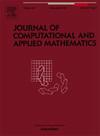具有动态边界条件的Cahn-Hilliard方程稳态的投影法
IF 2.1
2区 数学
Q1 MATHEMATICS, APPLIED
Journal of Computational and Applied Mathematics
Pub Date : 2025-04-07
DOI:10.1016/j.cam.2025.116674
引用次数: 0
摘要
Cahn-Hilliard方程是描述两相流或二元混合物相分离过程的基本模型。近年来,人们提出并分析了Cahn-Hilliard方程的动态边界条件。本文的第一个目标是提出一种投影方法来定位具有动态边界条件的CH方程的稳态。该方法的主要特点是只使用度量L2的变分导数,而不使用度量H−1的变分导数,从而大大减少了计算成本。此外,投影动力学满足重要的物理性质:质量守恒和能量耗散。在数值格式的时间构造中,采用凸分裂方法保证了大的时间步长。对表面势为双阱势或移动接触线势的二维金兹堡-朗道自由能进行了数值实验,验证了该投影方法的有效性。本文章由计算机程序翻译,如有差异,请以英文原文为准。
Projection method for steady states of Cahn–Hilliard equation with the dynamic boundary condition
The Cahn–Hilliard equation is a fundamental model that describes phase separation processes of two-phase flows or binary mixtures. In recent years, the dynamic boundary conditions for the Cahn–Hilliard equation have been proposed and analyzed. Our first goal in this article is to present a projection method to locate the steady state of the CH equation with dynamic boundary conditions. The main feature of this method is that it only uses the variational derivative in the metric and not that in the metric , thus significantly reducing the computational cost. In addition, the projected dynamics fulfill the important physical properties: mass conservation and energy dissipation. In the temporal construction of the numerical schemes, the convex splitting method is used to ensure a large time step size. Numerical experiments for the two-dimensional Ginzburg–Landau free energy, where the surface potential is the double well potential or the moving contact line potential, are conducted to demonstrate the effectiveness of this projection method.
求助全文
通过发布文献求助,成功后即可免费获取论文全文。
去求助
来源期刊
CiteScore
5.40
自引率
4.20%
发文量
437
审稿时长
3.0 months
期刊介绍:
The Journal of Computational and Applied Mathematics publishes original papers of high scientific value in all areas of computational and applied mathematics. The main interest of the Journal is in papers that describe and analyze new computational techniques for solving scientific or engineering problems. Also the improved analysis, including the effectiveness and applicability, of existing methods and algorithms is of importance. The computational efficiency (e.g. the convergence, stability, accuracy, ...) should be proved and illustrated by nontrivial numerical examples. Papers describing only variants of existing methods, without adding significant new computational properties are not of interest.
The audience consists of: applied mathematicians, numerical analysts, computational scientists and engineers.

 求助内容:
求助内容: 应助结果提醒方式:
应助结果提醒方式:


